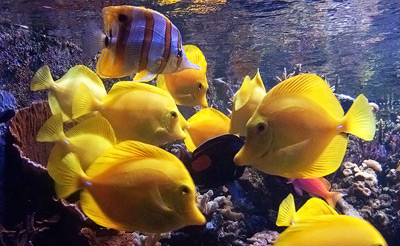You come home from a long, vexing day at work only to notice that the fish in your marine aquarium are all gasping at the surface of the water or cowering in a corner of the tank and behaving lethargically. Panicked, you promptly test your water parameters and discover that ammonia is present. The tank has long been cycled, so no ammonia should be detectable. What gives?
When an ammonia spike occurs in an already-cycled system, one of the following circumstances is usually the underlying cause:
#1: Overstocking
Adding “just one more” specimen to an aquarium that’s already close to being maxed out with respect to stocking capacity can easily lead to a situation in which more dissolved waste is produced than the biological filter can accommodate. It’s always better to stock lightly—even if that means the tank looks more sparse than you might prefer (the usual state of my aquariums)—than to push your luck with the bioload.
#2: Overfeeding
Excessive feeding of fish or invertebrates, which often results in uneaten food left decomposing in the system, is another surefire way to overwhelm an established system’s biofilter and cause ammonia to spike.
For most fish, it’s best to offer small, frequent feedings that can be consumed rapidly. If you keep a predatory species that requires large, meaty meals on a less-frequent basis (e.g., a grouper or moray eel), or if you offer relatively high volumes of planktonic food to invertebrates, keep in mind that water changes, filtration, and protein skimming must be sufficient to keep pace with the dissolved waste such feeding regimens typically produce.
#3: A dead specimen
A dead animal rotting in a marine aquarium can be a major source of ammonia—especially in smaller systems and with specimens of greater mass. So, whenever possible, it’s best to locate and remove deceased specimens. If removal isn’t practical, be ready to perform frequent water changes while the animal decomposes.
#4: An impaired biofilter
The loss of a portion of a system’s biofiltration capacity is a very common cause of ammonia spikes. This can happen, for example, when mechanical-filtration media (socks, sponges, etc.) are left in place long enough to become colonized with nitrifying bacteria and are then removed and replaced or aggressively rinsed.
Another possible biofilter-impairing scenario (of many) is a temporary power outage that shuts down circulation/aeration in the tank. Nitrifying bacteria require oxygenated water to thrive, so with the pumps out of commission, the dissolved oxygen level will soon begin to drop and the bacteria will begin to die off.
#5: Any combination of the above
Of course, if you can “answer yes” to more than one of the above scenarios—e.g., overstocking and overfeeding the tank, or the combination of a deceased specimen and the loss of some biofiltration capacity—the likelihood of an ammonia spike is all the greater.
What am I forgetting?
If I know me (and I do), I’m most likely forgetting something significant here. If any of you salties out there can think of other circumstances that lead to ammonia spikes in established systems, please feel free to share them in the comment section below.



